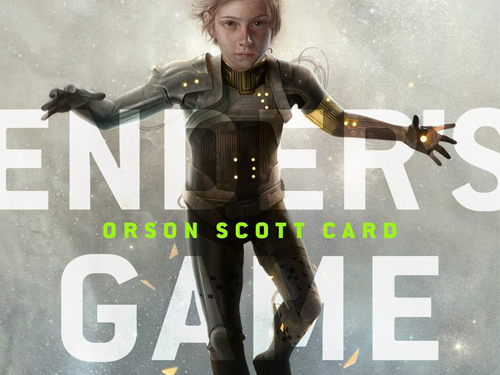ENDER'S GAME - Orson Scott Card talks about his Set Visit in Detail!

Here's an interesting article written by Ender's Game author Orson Scott Card where he talks about The Avengers as well as his visit to the set of the Ender's Game movie. He says some very interesting things that fans of the novel might not see as being a good thing, as he makes a point to say that this movie is not the book that he wrote, but he still had very positive things to say about it.
Here's a few things he had to say...
I was on the set of Ender's Game last week to record my one line in the movie – a voiceover of a pilot making an announcement to his passengers.
I sat, off-camera, reading my sole line, which comes in the middle of a scene between Harrison Ford as Col. Graff and Asa Butterfield as Ender Wiggin.
The scene does not come from the book – very few of the scenes in this movie do – so it was amusing when others asked me how it felt to have my book brought to life. My book was already alive in the mind of every reader. This is writer-director Gavin Hood's movie, so they were his words, and it was his scene.
He then addresses the performances of Harrison Ford as Colonel Graff and Asa Butterfield as Ender Wiggin.
And they were superb. Film acting, especially in closeup, is not about facial expressions. It's about what's going on behind the actors' eyes. And it's about timing.
He discussed the scene a little more in detail saying,
The scene got more and more minimal as the takes went on. What had been an arm grab and a shrug became a mere touch on the shoulder and a single glance at the hand.
And the less they did, the better the scene became. What mattered was the timing – when Ford put his hand on Butterfield's shoulder, how long it took Butterfield to glance at the hand, how long before he looked away and when the hand was withdrawn.On the set, however, it was wonderful to see how Ford and Butterfield responded to each other's timing. It was such a delicate dance – and they worked perfectly together.
His Thoughts on Ford,
The odd thing is that Harrison Ford gets little credit for the brilliance of his acting, because he's so real that audiences think that's just how he is.
Nonsense. Ford is a very inward man; everything he does on screen is acting, it's all very, very hard to do, and the fact that you think he's just being himself tells you how outstanding an actor he is.
His Thoughts on Butterfield,
And Butterfield is showing himself to be, not a child actor, but an actor who happens to be young. I've always said that, as a director, I'd rather have smart actors than talented ones, because your smart actors listen and change, and with those who fancy themselves talented, you have to rely on chance to get your performance.
Butterfield is smart. That really helps when he's supposed to bring off a preternaturally intelligent character. Actors can easily play dumb, but I've never seen an actor bring off a character that is smarter than he is. He's convincing as Ender Wiggin, so if the movie doesn't work, it won't be Butterfield's fault.
On the sets of the film that he saw,
I got a chance to explore the gorgeous sets designed and built by teams headed by production designers Sean Haworth and Ben Procter.
Again, they were not building anything from the book, so I wasn't seeing my ideas brought to life. Their job was to build the scenery dreamed up by Gavin Hood for his story, and they have done a wonderful job.
I love looking at well-designed sets – tough enough to be safe for the actors to work on, yet not wasting a dime on anything that won't show on camera. Haworth and Procter are a great team.The movie Ender's Game is going to look great.
On the special effects of defying gravity,
There is a mechanism used for training gymnasts – a wheel they wear around their waists that allows them to rotate in space while suspended from wires. Warren used this on Avatar, which allows a great deal of apparent freedom of movement in space – once the computer artists have erased the wheel rig, you can't tell that there's any way a wire could have been attached.
But this is only the beginning. The illusion of freefall depends on the actors' moving correctly. Where gravity naturally draws their limbs downward, in zero-gravity the arms and legs and heads continue in the direction of the last movement, until something stops them.
For the most difficult stunts, Warren brought in dancers from Cirque de Soleil. Being gymnasts by training, they tend to be small – they can bring off the illusion of children's bodies.
And they have the strength and training to do constant movements and poses that defy gravity, without ever looking as if they're working hard.
But all the children playing these roles had to do wire work themselves. Fitted with the wheel rigs, they were being moved through space like puppets – and at every moment, they had to make sure their "nonvolitional" movements followed the rules of inertia-driven rather than gravity-driven motion.
It was agonizing. Human muscles aren't meant to work like that. And Warren was watching everything, playing it back again and again, catching any false movements.
Get it wrong? Then you do it again.
Oh, how these kids suffered! I'm sure many of them had times when they dreaded each day's work.
I suggest you head on over to the full article and read it in its entirety as there's a lot more interesting and detailed stuff he says.
What do you think about what Card had to say here?